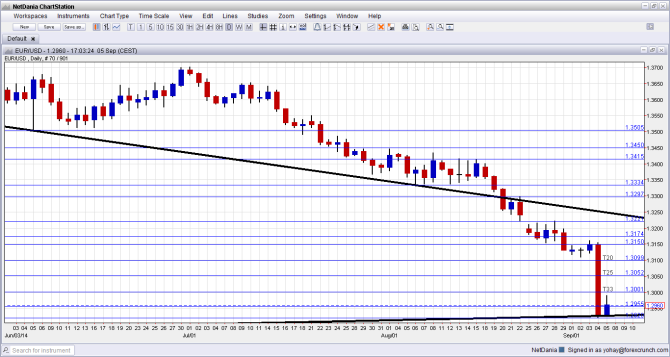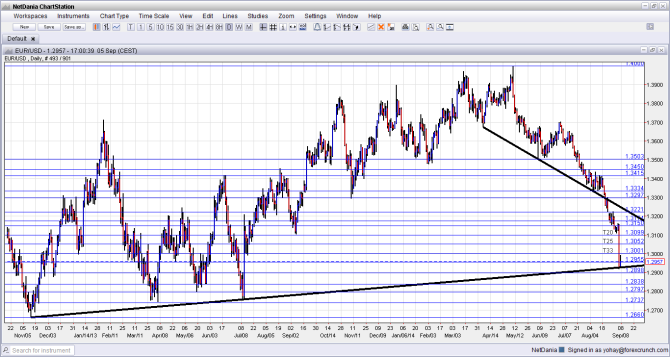EUR/USD had a dramatic week, falling once again and losing the 1.30 line as the ECB surprised with strong measures. Will we see more falls or can a correction be expected now? Trade balance figures, and industrial output numbers are among the indicators released this week. Here is an outlook on the highlights of this week and an updated technical analysis for EUR/USD, now on lower ground.
The ECB fired its guns: a surprising rate cut in all rates (including a deeper negative deposit rate) and an announcement about a “sizable” ABS program. While Draghi is avoiding government bonds, it is clear that the balance sheet is about to grow significantly, and this is euro-negative. Elsewhere in zone, forward looking PMIs did not really shine in the euro-zone, while German figures looked good. In the US, the economy gained only 142K jobs in August, but the miss in the NFP did not have a big impact on the greenback, as the US economy looks good in general. What’s next for the pair?
[do action=”autoupdate” tag=”EURUSDUpdate”/]EUR/USD daily chart with support and resistance lines on it. Click to enlarge:
- German Trade Balance: Monday, 6:00. Europe’s No. 1 economy enjoys a huge trade surplus. This inflow is one of things that kept the euro bid during long periods of time. After a surplus of 16.2 billion in June, a somewhat wider surplus is expected for July: 17.3 billion euros.
- Sentix Investor Confidence: Monday, 8:30. This survey of 2800 analysts and investors dropped sharply in August to 2.7 points, reflecting minimal optimism and the lowest level in nearly a year. Another small bounce is expected now, to 3.2 points.
- French Trade Balance: Tuesday, 6:45. Contrary to its neighbor, Europe’s second largest economy suffers from a chronic trade deficit. The deficits came out wider than predicted in the past two months. After 5.4 billion in June, a narrower deficit is likely now: 5 billion euros.
- French Final Non-Farm Payrolls: Wednesday, 5:30. This quarterly measure of employment has gone nowhere fast. The preliminary read showed a minimal gain of 0.1% in Q2. This number will likely be confirmed now.
- French Industrial Production: Wednesday, 6:45. After a few unexciting months, the French industry saw its output rise by 1.3% in June. The tables are expected to turn now, with a drop of 0.4%.
- German Final CPI: Thursday, 6:00. According to the preliminary reading, prices remained unchanged in August, and y/y, CPI rose by 0.8%, just like in July. These numbers will probably be confirmed towards the final all-European CPI figures.
- French CPI: Thursday, 6:45. This could be a more interesting release, as no preliminary numbers have been released, and it could impact the final read of CPI as well. A monthly rise of 0.4% is expected in prices.
- ECB Monthly Bulletin: Thursday, 9:00. One week after the much anticipated rate decision and press conference, the central bank releases its internal data, and we can learn what led to the change in forecasts and the dramatic decisions. The report usually has some impact on the euro.
- Italian Industrial Production: Friday, 8:00. The euro-zone’s third largest economy enjoyed a rise of 0.9% in output during June. A small slide cannot be ruled out now: 0.1% is expected.
- German WPI: Thursday, 6:00. The Wholesale Price Index index is yet another measure of inflation ,that is missing from the European scene. After a rise of 0.1% in July, a rise of 0.2% is expected in August.
- Industrial Production: Friday, 9:00. While previous figures for the main countries is already out by this time, the euro-area data is important, as we’ve seen with the disappointing 0.3% drop seen in June. A rise of 0.6% is expected, following up on the bounce seen in Germany.
- Employment Change: Friday, 9:00. This is a lagging figure: it relates to the second quarter of the year. After two consecutive rises of 0.1%, a third one is likely. Unemployment is very gradually coming down and employment is going up in the euro zone, as seen in the monthly unemployment rate releases.
* All times are GMT
EUR/USD Technical Analysis
Euro/dollar began the week without a gap this time, but it certainly fell to lower ground and could not really recover, as 1.3150 (mentioned last week) capped the pair. It all went sour from there: the pair fell below 1.31, bounced after dipping below 1.30, but eventually free fell to a new low of 1.2920 before stabilizing, above long term uptrend support.
Live chart of EUR/USD: [do action=”tradingviews” pair=”EURUSD” interval=”60″/]
Technical lines from top to bottom:
We start from lower ground this time. The 1.3415 level managed to cap the pair in August and serves as a barrier before 1.3450. Below, the next line of support is only at 1.3333, a level that worked as a cushion to the pair during August and just above 1.3325 that separated ranges back in September 2013.
1.3295 is the next line: it was the low level in November. 1.3220 is the pre-gap line and now serves as important resistance.
1.3175 worked in both direction during 2013 and served as the bottom line of the range in August 2014. 1.3150 is the fresh 2014 low and serves as a yearly low as well.
Below, the round number of 1.31 served as resistance several times, and the all important figure below is 1.30.
Even below 1.30, we find support at 1.2940 which had a role back in 2013. The new 2014 low of 1.2920 is immediate, yet not strong support.
1.2840 served as support in June 2013 and is the next line before the round number of 1.28, which also worked as support at around the same period of time.
1.2750 was the low where the pair traded last time it was around these levels: July 2013. This is followed by 1.2660 – a key line to the downside, which marks the beginning of long term uptrend support.
Long term uptrend support reached
After downtrend support was left behind, we are now reaching a much older line, which accompanied the pair since November 2012 and was touched twice in 2013 and since forgotten. It now returns to the scene, and the pair managed to bounce off this line, so far.
Here is the bigger picture graph:
I turn from bearish to neutral on EUR/USD
The long term trend is still down, and will probably remain so until the pair gets closer to 1.20. The fundamentals for a weaker euro are well in place, if to quote Draghi. The president of the ECB certainly hit the pair hard and it is not over yet. Nevertheless, after the big fall, the disappointing US NFP and the aforementioned support line, we may some consolidation before a resumption of the downwards move.
The wild card remains the volatile situation in Ukraine: a flare up after the more positive talks of peace could weigh on the euro.
More EUR/USD: Sturm Und Draghi
Further reading:
- For a broad view of all the week’s major events worldwide, read the USD outlook.
- For the Japanese yen, read the USD/JPY forecast.
- For GBP/USD (cable), look into the British Pound forecast.
- For the Australian dollar (Aussie), check out the AUD to USD forecast.
- USD/CAD (loonie), check out the Canadian dollar forecast
- For the kiwi, see the NZDUSD forecast.


